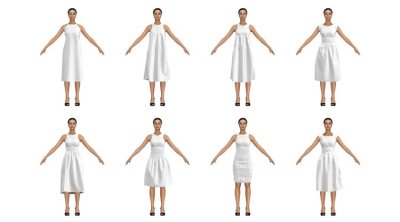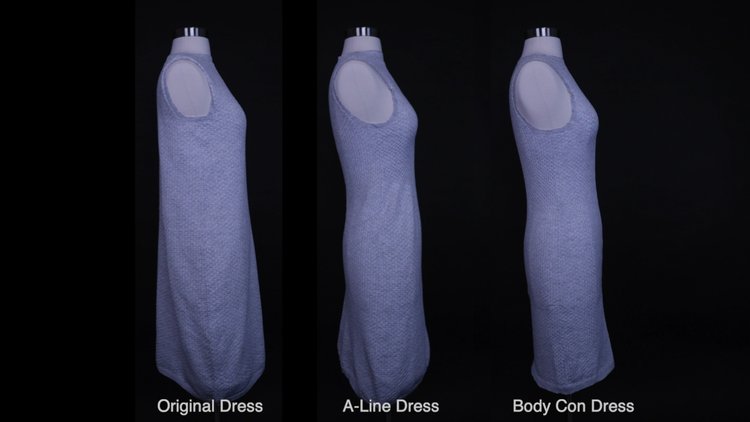Regular 2D sewing of anything is inherently wasteful. You can align the pattern pieces however you want, but there’s going to be wasted everything — thread, fabric, and interfacing — whether you get it right the first time or not. Never mind the fact that people tend to create a muslin (prototype) first using inexpensive fabric (like muslin) for the purposes of getting the fit right.

The MIT Self-Assembly Lab x Ministry of Supply have come up with a 4D garment construction technique that minimizes waste while being pretty darn cool at the same time. They’ve created a knit dress that combines several techniques and tools, including heat-activated yarns, computerized knitting, and 6-axis robotic activation. The result is a dress that can be permanently molded to fit the body however and wherever you want, using a heat gun mounted on a 6-axis robotic arm.
As far as we can tell, a finished dress does not come off of the machine in the short demo video after the break. It looks like it still has to be sewn together, which creates some potential for waste, but absolutely nothing like conventional methods.
This is probably the coolest dress we’ve seen since the one covered in LCD panels.

















Now we just need that shape-shifting humanoid robot mandrel that reenacts our whole body 3D scan during the procedure, and only after sharing it with 372 partner companies.
I just did it the Old Fashioned way.. Put my Victim in their Foundation Garments, Put a loose Fitting T Shirt on them, and start Strapping and Pulling Duct Tape in Sections around the Model, till you get the Shape you are looking for.
Then Cut the Ductaped T shirt off the Model, and Put it back on a Dress Form with a little Padding where needed to fill it back out in the right spots.
Crude, fast and Effective.. The ‘Zat-Chew’ ( ‘Is- That-You?) that is created will last about 6 Months before the Tape starts moving..
The Longer Term solution is to do a Paper Machete Form, but you can not get the ‘Corset’ Lines you can get with the Duct Tape Method..
Could combine the Two.. Gets Complicated then..
Cap
“Paper Machete”: there’s an interesting autocorrect…
I accidentally put my dress in the dryer, and it was a pair of shorts when it came out.
Remembers me of Zernike coefficients
We sew, knit, and weave in our house… not true. My wife does those things, but I love the math. I do use duct tape; does that count?
This just raises so many more questions on wasteful than it answers IMO. How long does the shaping last, just how hot does it have to be to shrink, does it wash easily and unharmed, being it seems a many layered knit is it actually able to make garments cool enough to be comfortable to wear in most weather, just how much energy was put into the fancy weaving and heatforming process and with unusual materials just how much extra energy do they embody. You might at that very very final stage not create much waste, but all the extra costs along the way count.
Its an interesting idea, which I can see many potential uses for. But without lots more questions answered it seems on the surface like it is probably more wasteful than sewing simple materials and recycling the waste fibres.
+1
So far I have gotten 15 years on my dacron aircraft covering, outside exposure. YMMV
There’s also the obvious point that if you start with 4 square meters of usable fabric, and end up with 3 square meters, you’re still “wasting” 25%. Instead of going straight to landfill, the waste is embedded in the finished product as excess mass (which then increases the energy cost of every trip you take while wearing it).
Of course, the real justification for research like this is just that it’s interesting. That’s suppossd to be why universities exist. It’s a shame they’re always making excuses for it.
The mass of that shrinking is only wasted if its not providing useful insulation or stretch, in this case it should I think be providing both (though I’m far from entirely sure of that). So as long as its cold enough…
I do agree though, interesting research should be done just because it is interesting and need no other justification – it may go somewhere fun and useful immediately, maybe its forgotten or going to be almost entirely forgotten before somebody else in the far future reads the paper and goes this is the solution I was looking for…
Now I can satisfy my girlfriend using a hot air blower!
Waaait, that comed out wroooong.
Can’t wait to make this a gift for my mother in law. “Go, stay in the sun or near the owen as long as you want. It will make you look slimmer”. Wrong again :b
This makes me remember the retractable beds (comming down from a false wardrobe) when they are not behaved. Or the predator automatic net.
Can’t wait to see where this is going. *chuckle*
I think waste is a red herring here; it’s really about customization. Making clothes that fit a wide range of people well is hard, and if you could mass-produce the dress in two or three sizes and then customize it in-store for a specific person that would be a win.
I have a feeling it doesn’t do very well in the dryer, though!
I’ve wonder why they simply don’t knit a specific 3d shape (that doesn’t require any post processing) and skip the 2D stage entirely. It would require a modified machine but it would be entirely seamless, waste free, wouldn’t require new materials, and it would be stronger because it’s a single piece.
This.
Knitting machines already exist to make a continuous tube, and they’re cheap enough to produce T-shirts, in arbitrary sizes, by the truckload. Have you seen a seam in a T-shirt recently?
Not a great stretch(!) to make it variable diameter, and knit-on-demand. Serging the hem and other holes might be a separate operation, but I’m sure that could be semi-automated too.
I think the idea is mass production. You ship a mountain of the “preshrunk” garments to your store, and then the store only needs to do the shrink-to-order process on-demand.
Of course, I suspect knitting machines are cheaper to put in each store than the industrial robot arm used here. But the robot arm has a higher cool factor — and as evidenced by the robot arm bartenders on cruise ships etc people will pay for the robot.
yeah i had the same idea! it’d take a pretty complicated machine to be able to do all of the ‘increasing’ and ‘decreasing’ and like ‘cast on sleeves to the edge of an existing piece’ sort of maneuvers. but i dream of a proper knitting machine that can make perfect shapewear.
Isn’t this like when women would wear a pair of jeans in a hot bath to make them conform to their body and fit tighter?
4D? I guess it’s true what they say: A stitch in time saves nine.
Except clothes are 2d pretty much by definition.
So the waste using traditional method < the energy consumption of the heat gun, 6 motors and all the machines involved in design? I don't think so, however I can see this machines in fancy fashion stores and people taking selfies and making shorts vids cos is cool and expensive.